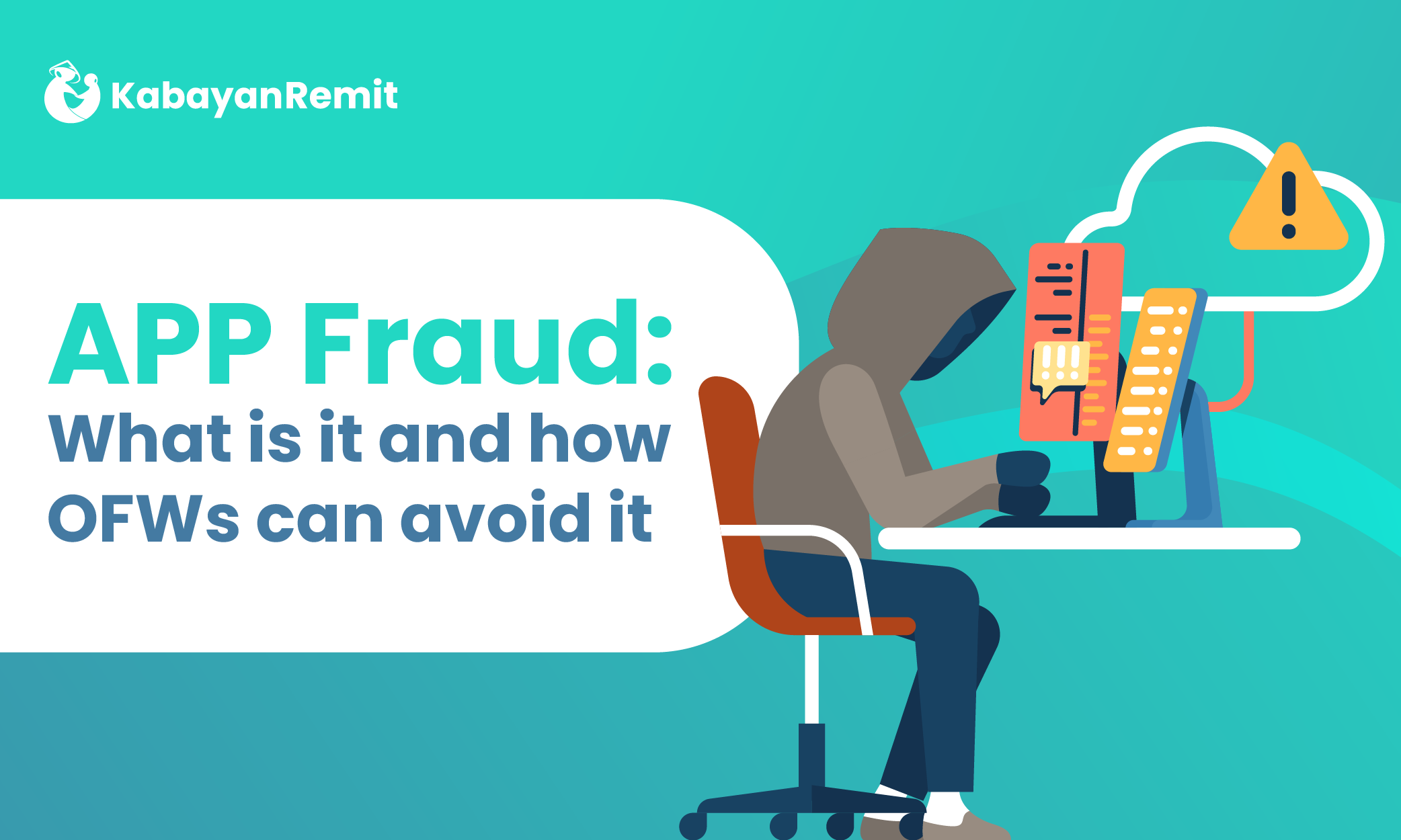
APP fraud: What is it and how OFWs can avoid it
APP stands for authorised push payments, while APP fraud happens when an unsuspecting victim loses access to their precious funds by willingly sending money from their account to a scammer’s account. People fall for this scam because fraudsters pretend to be someone a person trusts, like a loved one or a reputable organisation or business. This causes APP fraud victims to suffer heartbreaking consequences, often waiting months to recover their savings.
According to a recent report by UK Finance, a banking and finance organisation in the United Kingdom, APP fraud has drained accounts of ₤459.7 million in the past year. And as more victims continue to come forward, overseas Filipino workers should stay on the lookout for APP fraudsters—especially now that the Christmas season and the holiday shopping rush are in full swing.
To learn more about APP fraud, how it looks, and what to do if you or someone you know has been scammed, read on.
What are the types of APP fraud?

According to the UK’s Payment Systems Regulator, there are two types of APP fraud:
Malicious Payee
This type of APP fraud fools a person into paying for a fake product or service. For example, a victim visits an online shop to buy a bogus product. After a few days, they realise that the product will never arrive, and the money they used as payment is gone.
Malicious Redirection
This type of APP fraud involves a scammer pretending to be someone trustworthy to trick a victim into transferring money into a fraudulent account. For example, a supposed bank employee contacts a victim to inform them about the possible closure of their account. To avoid losing access to their account, the victim is told they must make an emergency deposit using a special link. After the deposit has been made, the victim learns there was never an emergency and the “bank employee” they were in contact with has disappeared along with their money.
Some subtypes of APP fraud
Under these two types of APP fraud are more specific subtypes of scams that defraud well-meaning people of their money. These subtypes include but are not limited to:
- Invoice and mandate scams – Usually found in email inboxes, a scammer interferes with a legitimate transaction by pretending to represent the payee. The scammer then convinces a victim to send their payment to a “new” payee account.
- CEO fraud – A scammer convinces a victim to send them money by pretending to be an important person in the victim’s organisation.
- Impersonation scam – A scammer convinces a victim to send them money or personal details by pretending to be the police, a bank employee, or a loved one. This scammer may target their victim via personal messaging platforms, or they may even use deception to gain remote access to their victim’s computer.
- Purchase scam – A victim purchases an item on a bogus online store. They never receive the item and lose some money in the process.
- Investment scam – A scammer tells a victim they can double their savings by investing in a fake investment fund or project. After receiving the investment money, the scammer disappears and leaves the victim empty-handed.
- Romance scam – A scammer will woo a victim online. Once they have the victim’s heart and trust, the scammer will convince the victim to send them money.
- Advance fee scam – The victim receives a message or email saying they have won a prize or have been given an inheritance. To claim the prize, the victim must pay a fee. The victim pays the fee, but never receives the prize.
Read more about the top 10 online scams OFWs should avoid here.
What are the signs of APP fraud?

While OFWs should be careful when managing their finances online, they should also be alert when receiving messages or phone calls about money. According to UK Finance, most APP fraud cases in 2023 happened online; however, victims experienced the biggest losses from APP scams conducted through telecommunications.
When it comes to fraud, prevention is better than the cure. Before you pay, look out for these signs of APP fraud:
It’s too easy.
If it sounds like you can get rich by simply depositing so-and-so amount, or if a hot item comes with a huge discount, think twice. As the saying goes, it’s too good to be true.
They don’t sound like they usually do.
Be concerned if you receive a message from an address or messaging platform that a business, organisation, or loved one has never been known to use. Read their messages carefully, and ask yourself: Do they usually write or talk this way? If the answer is no, then it may be APP fraud.
You need to act now, now, now.
An APP fraudster will try to push you into sending money ASAP by triggering your stress or targeting your fear of missing out. They may tell you that if you don’t send money now, you’ll miss out on an exciting promo; or, they could scare you into sending money by saying you could lose access to your account. They may even pretend they’re in an emergency, and only your money can help them.
It’s a different process than usual.
You’re about to make a deposit, but you notice that the person or business you’re sending money to is using a different account or payment method than usual. Before you hit “send,” call your friend or contact the business’s official hotline as this may be APP fraud.
They want your password.
Remember: Legit businesses will not ask for your personal details through email or text. And they will not pressure you into giving this information if you do not want to.
Now that you know the signs of, brush up on your online security practices to better avoid APP fraud.
I’ve been scammed! What should I do?

If you’ve become a victim of APP fraud, contact your bank immediately. They may still be able to keep your funds from reaching your scammer.
If you’re based in England, Wales, and Northern Ireland, you may also report APP fraud by calling Action Fraud at 0030 123 2040 or by contacting the team online.
If you are in Scotland, contact Police Scotland as soon as possible.
If you’re in the UK, there’s still a chance to get your money back.
Starting 7 October, High Street Banks, building societies, and e-money firms are required by the PSR to reimburse APP fraud victims. Financial institutions are now required to reimburse a maximum of £85,000 to a victim within five business days from receiving their APP fraud report.
Victims of APP fraud who are unhappy with how their banks are handling or have handled their cases, may escalate their complaints to the Financial Ombudsman Service.
The UK is pushing back against APP fraud.
Institutionally, banks and other financial institutions are also increasing their layers of security by employing identity verification methods to ensure their clients’ funds reach the right people. The UK has also banned cold calls pushing financial products as another way to curb APP fraud.
Use a secure remittance app to send money to the Philippines

APP fraud can happen at any time, so it pays to be alert when dealing with the money you worked so hard to earn. When sending money to the Philippines, always use a secure money transfer app like Kabayan Remit.
Kabayan Remit is an OFW-centred remittance app with bank-level security and data encryption that allows OFWs like you to safely send money from the UK, Canada, and the United States to reputable banks, e-wallets, and remittance centres in the Philippines.
To ensure your money reaches the right account, the app requires you to input your beneficiary’s mobile number or bank details from the moment you open an account. Kabayan Remit also offers 24/7 bilingual customer support in case of emergencies.
Start sending money to the Philippines from the comfort of your own phone, by following these three easy steps:
- Download the Kabayan Remit app here.
- Input your loved one’s details. This can be their mobile number or their bank account.
- Tap “send money” and begin remitting money to the Philippines.
The sooner you start sending love, the faster you can become eligible to win a free roundtrip ticket to the Philippines!
